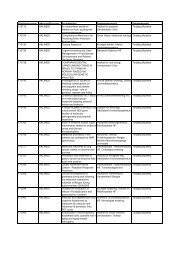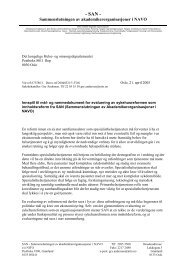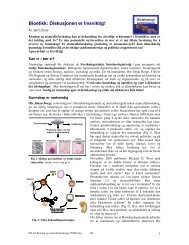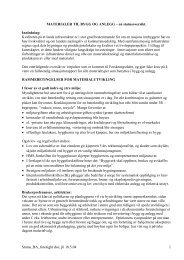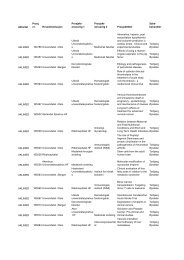A Revolution in R&D
A Revolution in R&D
A Revolution in R&D
Create successful ePaper yourself
Turn your PDF publications into a flip-book with our unique Google optimized e-Paper software.
ESTABLISHING A UNIFIED INFORMATICS INFRASTRUCTURE<br />
For a company to extract full value from the new<br />
technologies and the copious data that will emerge<br />
from them—that is, to transform data <strong>in</strong>to knowledge—it<br />
will have to devise a comprehensive <strong>in</strong>formatics<br />
vision and architecture. The vision will articulate<br />
the role of <strong>in</strong>formatics as a potential source of<br />
competitive advantage. The architecture will have<br />
three essential components<br />
First, there must be an optimized <strong>in</strong>formation flow<br />
across the newly <strong>in</strong>dustrialized research and development<br />
value cha<strong>in</strong>. Standards will need to be<br />
established to ensure that data are formatted, organized,<br />
and def<strong>in</strong>ed consistently. Hardware and<br />
applications will have to be l<strong>in</strong>ked and networked<br />
appropriately so that <strong>in</strong>formation can move where it<br />
needs to, feed<strong>in</strong>g subsequent steps <strong>in</strong> the process.<br />
Second, a centralized knowledge management system<br />
is required, to capture and store the data, <strong>in</strong>tegrate<br />
it with external data, and make it available<br />
throughout the company. F<strong>in</strong>ally, powerful analytical<br />
tools will be required, to m<strong>in</strong>e and make sense of the<br />
data—sophisticated algorithms, visualization tools,<br />
and so on.<br />
To develop and <strong>in</strong>tegrate these components, most<br />
companies will have to <strong>in</strong>vest heavily. The costs may<br />
look particularly high <strong>in</strong> relation to traditional costs,<br />
but that is partly because the <strong>in</strong>dustry has generally<br />
under<strong>in</strong>vested <strong>in</strong> IT. (One large biotech company, follow<strong>in</strong>g<br />
its <strong>in</strong>formatics upgrade, reports a threefold<br />
<strong>in</strong>crease <strong>in</strong> its annual IT budget.) To focus the <strong>in</strong>vestment<br />
accurately, a coherent plan is once aga<strong>in</strong><br />
essential. A critical decision is whether to develop<br />
the capabilities <strong>in</strong>-house, outsource to solutions<br />
providers, or purchase and <strong>in</strong>tegrate <strong>in</strong>formatics<br />
packages. The choice or choices made will depend<br />
on such factors as available <strong>in</strong>ternal expertise, the<br />
amount of <strong>in</strong>tegration with legacy <strong>in</strong>formation sys-<br />
tems required, and the availability of reliable <strong>in</strong>tegration<br />
vendors, package suppliers, or solutions<br />
providers.<br />
That last factor may prove particularly difficult to<br />
assess. Who would provide the most reliable and<br />
suitable assistance? Today, no s<strong>in</strong>gle provider of<br />
application software provides all the functionality<br />
needed. The <strong>in</strong>formatics <strong>in</strong>dustry is crowded with<br />
small start-ups offer<strong>in</strong>g niche products; the cumulative<br />
market capitalization of all publicly listed bio<strong>in</strong>formatics<br />
companies scarcely amounts to one-eighth<br />
of GlaxoSmithKl<strong>in</strong>e’s annual R&D budget. And while<br />
larger IT solutions providers are gear<strong>in</strong>g up to serve<br />
the burgeon<strong>in</strong>g needs of this market, they are still <strong>in</strong><br />
the process of develop<strong>in</strong>g <strong>in</strong>ternal life-sciences capabilities.<br />
Given that each prospective solutions<br />
provider is likely to try to make its offer<strong>in</strong>g the centerpiece<br />
of the company's <strong>in</strong>formatics architecture,<br />
and given that multiple solutions will need to be<br />
knitted together, companies would be wise to solicit<br />
<strong>in</strong>dependent, unbiased advice before decid<strong>in</strong>g on<br />
particular vendors.<br />
In addition to manag<strong>in</strong>g all this <strong>in</strong>formatics complexity,<br />
companies will have to deal with a further<br />
challenge if they are to implement the new <strong>in</strong>formation<br />
regime successfully. They will have to f<strong>in</strong>d a way<br />
to resolve the human-resources and organizational<br />
issues that are bound to arise. Talented, experienced<br />
<strong>in</strong>formatics personnel are difficult to come by: how<br />
to f<strong>in</strong>d and keep the right people and how to fit them<br />
<strong>in</strong>to the organizational structure are questions that<br />
companies will need to address more actively and<br />
imag<strong>in</strong>atively than ever. So too the question of how<br />
to change processes and behaviors generally,<br />
throughout the organization, to ensure fullest use of<br />
the new <strong>in</strong>formatics tools—a question exam<strong>in</strong>ed <strong>in</strong><br />
some detail elsewhere <strong>in</strong> this chapter.<br />
51



